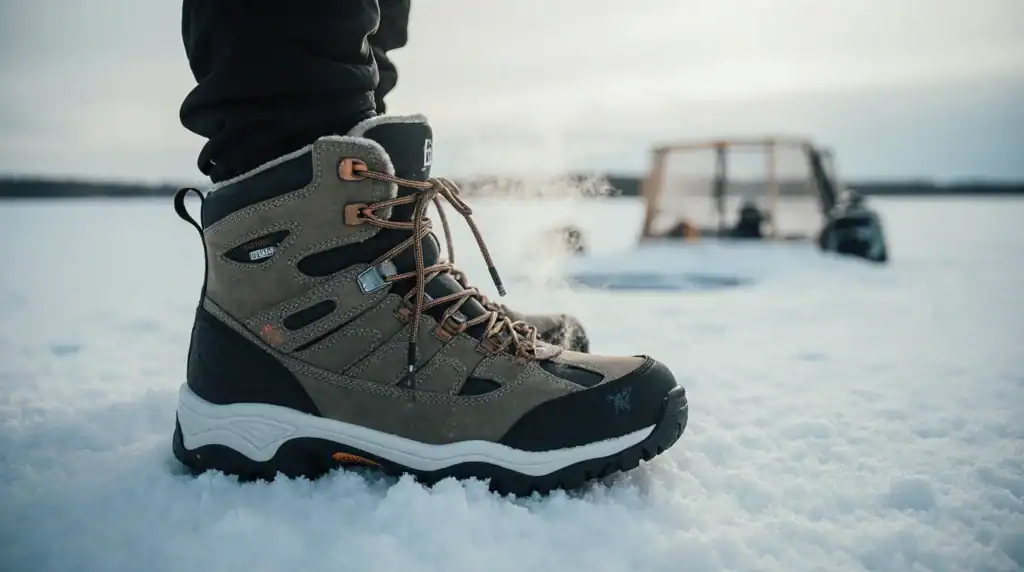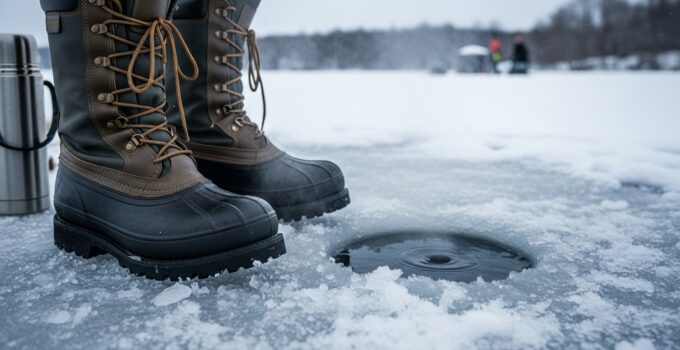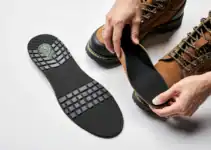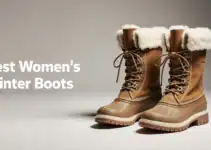Last Updated: October 24, 2025 | Tested By: The BootsGuru Team
There’s nothing quite like the thrill of pulling a monster through the ice. But let’s be honest: sitting for hours on a frozen lake can be brutal if your feet turn into blocks of ice by 9 AM. Standard winter boots often just don’t cut it against the penetrating cold, treacherous ice, and inevitable slush found during ice fishing.
Choosing the right ice fishing boot isn’t just about comfort; it’s about safety and endurance. You need serious insulation, guaranteed waterproofing, and reliable traction to stay warm, dry, and upright. Forget flimsy hikers or leaky work boots – you need specialized gear.








We’ve analyzed the features, scoured user feedback, and leveraged our expertise to bring you the definitive guide to the best ice fishing boots for 2025. We’ll break down exactly what makes a boot truly ice-ready and review the top picks that will keep your feet happy from drill-down to final catch.

Choosing the right boots is crucial for warmth and safety on the ice.
Quick Picks: Top 5 Ice Fishing Boots for 2025
| Award | Boot Model | Best For | Key Feature | Temp Rating (Approx.) | Price |
|---|---|---|---|---|---|
| 🏆 Best Overall (Extreme Cold) | Baffin Impact | Maximum Warmth & Durability | 8-Layer Removable Liner | -100°C / -148°F | $$$$ |
| 💪 Best All-Around Pac Boot | Kamik Greenbay 4 | Reliable Warmth & Value | Removable 8mm Liner | -40°C / -40°F | $$ |
| 🚶♂️ Best for Mobility & Comfort | Muck Boot Arctic Sport | Active Fishing & Walking | 5mm Neoprene Bootie | -40°C / -40°F | $$$ |
| 🔒 Best Traction System | Korkers Polar Vortex 1200 | Adaptable Grip (Interchangeable Soles) | OmniTrax Sole System | -51°C / -60°F | $$$$ |
| 💰 Best Budget Pick | Kamik Canuck | Affordable Cold Weather Protection | Removable 8mm Liner | -40°C / -40°F | $$ |
The Ice Angler’s Boot Bible: Non-Negotiable Features
Ice fishing demands more from your boots than any other winter activity. Here’s what truly matters:
Warmth: Insulation & Temperature Ratings
This is paramount. Look for:
- Temperature Rating: Manufacturers provide ratings (e.g., -40°F, -100°F). Treat these as a *guideline* for ideal conditions (active use, good socks). Always choose a rating significantly *lower* than the coldest temperature you expect to encounter, especially if you’ll be sitting still.
- Insulation Type & Amount:
- Removable Liners (Pac Boots): This is the classic, proven system. Multi-layer felt or synthetic liners (like Baffin’s 8-layer system or Kamik’s Zylex®) trap heat effectively and, crucially, can be removed overnight to dry completely – essential for multi-day trips.
- Built-In Insulation (e.g., Thinsulate™): Common in hunting or hybrid boots. Measured in grams (e.g., 800g, 1200g, 2000g+). Effective, but the boot itself takes longer to dry if it gets damp inside. For sedentary ice fishing, aim for *at least* 800g, with 1200g+ being much better.
- Neoprene Booties (e.g., Muck Boots): Offers good insulation (typically rated by mm thickness, e.g., 5mm or 8mm) combined with flexibility and 100% waterproofing in the lower boot.
Traction: Staying Upright on Slick Ice
Ice is inherently slippery. Your boots need serious grip:
- Sole Material: Look for soft rubber compounds specifically designed to stay flexible and grippy in freezing temperatures. Hard plastic soles become dangerously slick.
- Lug Pattern: Deep, multi-directional lugs help bite into snow and packed ice. Some boots feature specialized ice-gripping compounds (like Vibram® Arctic Grip), though these are less common on bulky pac boots.
- Ice Cleats (Highly Recommended): For glare ice, no boot sole alone is perfectly safe. Investing in a good pair of removable ice cleats (microspikes or studded grips) that fit over your boots is the *best* way to guarantee traction. Consider boots with relatively flat sole areas compatible with cleats.
Waterproofing: Slush Happens
You *will* encounter water – drilling holes, melting snow, unexpected slush pockets. 100% waterproofing is mandatory.
- Pac Boot Construction: The gold standard. A molded rubber lower shell completely seals out water, combined with a water-resistant upper (nylon or leather).
- Neoprene Boots: Naturally waterproof in the bootie section.
- Seam Sealing & Gaiter/Collar: Look for sealed seams on the upper and an adjustable snow collar or built-in gaiter at the top to prevent snow and slush from falling inside.
Fit & Comfort: Sizing for Socks & All-Day Wear
- Sizing for Layers: Ice fishing boots are often sized generously to accommodate thick thermal socks (or multiple sock layers). It’s common to order your regular size or even a half-size up. Check manufacturer recommendations. Your toes need wiggle room – tight boots restrict blood flow and lead to *colder* feet.
- Weight vs. Warmth: Extreme cold protection often means a bulkier, heavier boot (especially pac boots). If you plan to walk long distances (“hole hopping”), consider a slightly lighter but still highly insulated option like a Muck Boot or Korkers.
- Removable Liner Benefit: Beyond drying, removable liners allow you to adjust insulation slightly if needed.
Top 5 Best Ice Fishing Boots: Detailed Reviews
🏆 Best Overall (Extreme Cold): Baffin Impact

The Honest Take: When conditions get truly arctic, the Baffin Impact is the benchmark. Its legendary warmth comes from an 8-layer removable inner boot system that traps heat like a thermos. The durable rubber base and tough nylon upper are completely waterproof and built to withstand years of abuse. Yes, it’s bulky, but if your priority is staying warm while sitting stationary on the ice for hours in sub-zero temperatures, nothing beats the Impact’s proven thermal performance.
| Pros | Cons |
|
|
Best For: Ice anglers in the coldest climates, stationary fishing (ice houses, tip-ups), multi-day trips where liner drying is essential.
💪 Best All-Around Pac Boot: Kamik Greenbay 4

The Honest Take: The Kamik Greenbay 4 is a perennial favorite for a reason: it offers reliable pac boot performance at an excellent value. The -40° rating is genuinely effective for most ice fishing conditions, thanks to the removable 8mm Zylex® liner. The waterproof rubber lower and 600 denier nylon upper keep you dry, and the adjustable snow collar does its job. It’s lighter than the extreme Baffin models, making it a bit easier to walk in. While the sole isn’t amazing on glare ice (use cleats!), it provides decent grip on snow and packed surfaces. A solid, dependable choice that won’t break the bank.
| Pros | Cons |
|
|
Best For: Most ice anglers, budget-conscious buyers, variable winter conditions.
🚶♂️ Best for Mobility & Comfort: Muck Boot Arctic Sport

The Honest Take: If you’re an active ice angler who moves around a lot (“hole hopping”) or walks significant distances to your spot, the Muck Boot Arctic Sport offers a great blend of warmth, waterproofing, and *mobility*. Instead of a stiff pac boot, it uses a 5mm neoprene bootie construction that’s naturally insulating, 100% waterproof, and much more flexible. The fleece lining adds warmth and comfort. The sole offers better all-around traction than many basic pac boots. It’s a supremely comfortable, versatile boot, though the non-removable liner takes longer to dry if it gets wet inside.
| Pros | Cons |
|
|
Best For: Active ice anglers, those walking longer distances, transitioning between ice and snow/slush.
🔒 Best Traction System: Korkers Polar Vortex 1200

The Honest Take: For the angler who demands the absolute best, adaptable traction, Korkers are in a league of their own. The Polar Vortex features their brilliant OmniTrax® Interchangeable Sole System. This means you can swap between different outsoles in seconds – put on the aggressive SnowTrac lugs for deep snow, then switch to the Carbide Studded sole for unbeatable grip on pure, slick ice. Beyond the soles, it’s a high-performance boot with 1200g Thinsulate insulation, waterproof construction, and a Boa® lacing system for a perfect, quick fit. It’s a premium, technical boot for serious conditions.
| Pros | Cons |
|
|
Best For: Anglers needing the best possible grip on varied ice/snow, technical users, those willing to invest in a premium system.
💰 Best Budget Pick: Kamik Canuck

The Honest Take: Very similar in design and performance to the Greenbay 4, the Kamik Canuck is another excellent budget-friendly pac boot. It features the same -40° rating, a removable 8mm Zylex® liner, a waterproof rubber lower, and a durable nylon upper with an adjustable snow collar. The main difference often lies in minor styling or fit variations, and sometimes price. If you find the Canuck at a better price than the Greenbay 4, it’s a fantastic, reliable option for staying warm and dry without spending a fortune.
| Pros | Cons |
|
|
Best For: Budget-conscious anglers, backup pair, moderate ice fishing conditions.
Gear Up: Essential Ice Fishing Boot Accessories
Your boots are the foundation, but these add-ons maximize safety and comfort:
7.1. Ice Cleats / Creepers
Non-negotiable for glare ice. Even the best boot soles struggle on smooth, wet ice. A good pair of removable ice cleats (with hardened steel spikes or coils) provides crucial bite and prevents dangerous falls. Look for brands like Kahtoola MICROspikes, Yaktrax, or similar heavy-duty options designed to fit over bulky winter boots.
7.2. High-Quality Socks
Your boots’ insulation won’t work effectively if your socks get damp. Invest in good socks:
- Merino Wool: The absolute best. Naturally temperature-regulating, moisture-wicking (even when damp), and odor-resistant. Choose a mid-weight to heavy-weight cushion.
- Synthetic Blends: Good alternatives, often blending materials like polyester, nylon, and spandex for moisture-wicking and durability.
- Avoid Cotton: Cotton absorbs moisture and holds it against your skin, rapidly chilling your feet. Never wear cotton socks for ice fishing.
- Layering: Consider a thin liner sock (synthetic or silk) under a thicker wool sock for maximum moisture management.
Frequently Asked Questions (FAQ)

Reliable traction and warmth are essential for ice fishing boots.
How accurate are the temperature ratings on ice fishing boots?
Treat them as a guideline for *active* use in ideal conditions. Factors like your circulation, sock quality, humidity, wind chill, and whether you’re sitting still vs. moving significantly impact warmth. Always err on the side of a *warmer* rating (lower temperature) than you think you need, especially for stationary fishing.
Why are removable liners important?
Two main reasons: 1) Drying: Your feet sweat, even in the cold. Removable liners can be pulled out overnight to dry completely, preventing a damp (and cold!) start the next day and inhibiting bacteria/odor. 2) Insulation: Multi-layer liners are incredibly effective at trapping air and providing high levels of insulation.
How should ice fishing boots fit with thick socks?They should feel snug but not tight when wearing your intended thick sock system. You MUST have enough room to wiggle your toes freely. If your toes are cramped, it restricts blood flow and makes your feet colder, regardless of the insulation. Trying boots on late in the day (when feet are slightly swollen) with your thickest socks is recommended.
Do I *really* need separate ice cleats?
For smooth, glare ice? Yes, absolutely. While some boot soles are better than others, the risk of a fall on pure ice is high. Cleats provide a level of safety that no boot sole alone can guarantee in those conditions. Consider them essential safety gear.
Conclusion: Don’t Let Frozen Feet Cut Your Day Short
Choosing the right ice fishing boots is a critical investment in your comfort, safety, and ability to enjoy your time on the ice. Prioritize extreme warmth (check those temp ratings and insulation!), guaranteed waterproofing (pac boots or neoprene are best), and reliable traction (and plan on using cleats for glare ice).
For the absolute coldest conditions where maximum warmth is paramount, the Baffin Impact is legendary. For a fantastic balance of warmth, value, and reliable performance, the Kamik Greenbay 4 or Canuck are hard to beat. And if you value mobility and walking comfort, the Muck Boot Arctic Sport is an outstanding choice. Consider the Korkers if you need the ultimate, adaptable traction system.
Invest in good boots, pair them with quality socks and cleats, and you’ll be set for many comfortable and successful seasons on the hard water.










